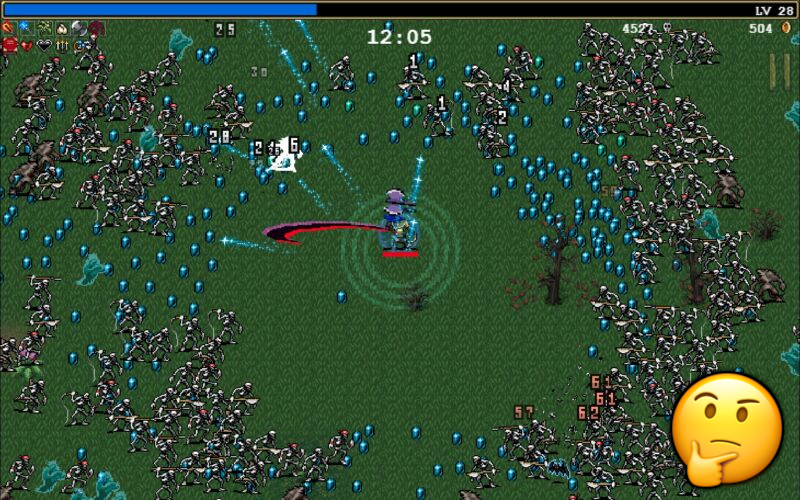Some have called 2022 the year of "microgames". In the wake of @poncle_vampire a host of ~$2 games were created mostly by solo developers or tiny #IndieDev teams in the span of a few months.
Let's talk game dev experimentalism!
🧵👇 1/9



Let's talk game dev experimentalism!
🧵👇 1/9




2/9
The reception, surrounding many of these titles is open, forgiving and appreciative. Turns out if players didn't spend $60 and didn't get hyped up for years of dev time by a faceless corporation, the human side of #GameDev actually shines through sometimes, even on Steam.
The reception, surrounding many of these titles is open, forgiving and appreciative. Turns out if players didn't spend $60 and didn't get hyped up for years of dev time by a faceless corporation, the human side of #GameDev actually shines through sometimes, even on Steam.

3/9
This in turn opens up #GameDesign space. "Bullet heaven" is a result of flipping a genre on its head: YOU are the bullet hell! Of course there's iteration in microgames too, but the possibility to experiment is real (e.g. @caiysware's "What if your bullets are minions?").



This in turn opens up #GameDesign space. "Bullet heaven" is a result of flipping a genre on its head: YOU are the bullet hell! Of course there's iteration in microgames too, but the possibility to experiment is real (e.g. @caiysware's "What if your bullets are minions?").




4/9
The brilliant @PUNKCAKE_delice have made exactly this experimentation their whole mission as a studio: one game a month, each one mechanically unique. What if Minesweeper, but twin-stick? What if tower-defense, but match-3? What if Pong, but it's actually a #roguelike shmup?



The brilliant @PUNKCAKE_delice have made exactly this experimentation their whole mission as a studio: one game a month, each one mechanically unique. What if Minesweeper, but twin-stick? What if tower-defense, but match-3? What if Pong, but it's actually a #roguelike shmup?




5/9
Of course the "regular game jam" model existed before, most notably in the form of the inexhaustibly creative @sokpopco. In the midst of this new microgame-welcoming atmosphere though, they had a big breakout hit with the unique Stacklands.
Of course the "regular game jam" model existed before, most notably in the form of the inexhaustibly creative @sokpopco. In the midst of this new microgame-welcoming atmosphere though, they had a big breakout hit with the unique Stacklands.

6/9
At the same time @panic is rolling out their #Playdate handheld that encourages experimentation by design: It comes with minimal buttons and a seemingly retro 1-bit display, but at the same time features a physical crank, i.e. an entirely new kind of continuous input.
At the same time @panic is rolling out their #Playdate handheld that encourages experimentation by design: It comes with minimal buttons and a seemingly retro 1-bit display, but at the same time features a physical crank, i.e. an entirely new kind of continuous input.
7/9
I've mentioned platforms like @Pokittocom, @theGamebuino or @bateskecom's Arduboy that create ecosystems encouraging small projects and experiments.
As #PICO8's @lexaloffle put it: "I just love to see isolated little thoughts." (@NYUGameCenter talk: )



I've mentioned platforms like @Pokittocom, @theGamebuino or @bateskecom's Arduboy that create ecosystems encouraging small projects and experiments.
As #PICO8's @lexaloffle put it: "I just love to see isolated little thoughts." (@NYUGameCenter talk: )




8/9
At this point, another shoutout is due to content creators out there who embrace experiments, who don't shy away from taking smaller titles seriously: @Esty8nine, @extarscube, @MrDelightful2, @nookrium, @OlexaYT, @RetromationYT, @SplattrCatGames, @TheTimeToGrind, @wildfremdYT



At this point, another shoutout is due to content creators out there who embrace experiments, who don't shy away from taking smaller titles seriously: @Esty8nine, @extarscube, @MrDelightful2, @nookrium, @OlexaYT, @RetromationYT, @SplattrCatGames, @TheTimeToGrind, @wildfremdYT




9/9
We see more instances of "games as conceptual art", beautiful small windows into specific creative minds, come to the surface: fischerdesign.medium.com/games-as-conce…
In an industry where the big projects are becoming increasingly anonymous assembly line productions, that's very refreshing.
We see more instances of "games as conceptual art", beautiful small windows into specific creative minds, come to the surface: fischerdesign.medium.com/games-as-conce…
In an industry where the big projects are becoming increasingly anonymous assembly line productions, that's very refreshing.

• • •
Missing some Tweet in this thread? You can try to
force a refresh




























